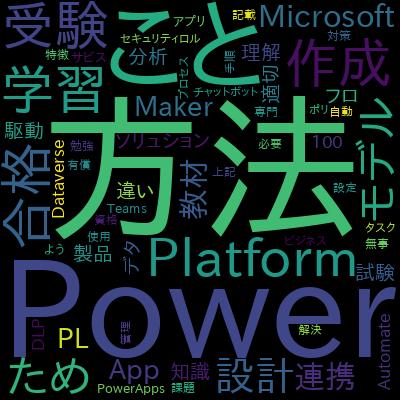【評判】PL-200:Microsoft Power Platform Functional Consultant Part 1
講座情報
- ・講師名:Phillip Burton • 975000+ students so far(詳しい経歴はこちら)
- ・作成日:2021-05-14
- ・レクチャー数:151
- ・週間:0記事
- ・月間:0記事
- ・年間:0記事
- ・全期間:1記事
レビュー数
レビュー数の推移
直近6か月以内に本講座のレビューに関して記載された記事はありません。
学習内容
Create Power Automate flows
Configure and manage Microsoft Dataverse
Create and consume Microsoft Power BI dashboards
Describe AI Builder models
詳細
This course covers some of the content required for the PL-200 certification exam. It follows the requirements of the PL-100 exam (no longer offered by Microsoft), which is then built on in the PL-200 exam.
Please note: This course is not affiliated with, endorsed by, or sponsored by Microsoft.
What do people like you say about this course?
James says: "Another awesome course from Philip. This course goes though all the major topics on the PL-100 exam in great detail and step-by-step, I followed along on my own trial tenant which I highly recommend. Take your time and go through it all!"
Will says: "This whole series has been fantastic; the best I have seen on this topic!"
Nikhil says: "Awesome course for PL100 Exam preparation. Updated: After completing the course I got the confidence to go ahead and attempt the exam. I m proud to announce that I passed on first attempt."
Stephen says: "I didn't even know what I didn't know until I took your course. You dragged me through topics I never knew I needed. The exposure helped me to guess correctly on the test (the second time). Your course was the most thorough coverage I could have received. Your coverage was so extensive, that I have to go back and review segments. It says 16 hours--but I'm sure I spend over 120 hours on the material. Part of the time I tried to duplicate your magic. Again, Thanks 6 stars."
This course focuses on the various apps which make up the Power Platform, together with how they can be used by other programs, apps and services. It covers many of the requirements of the PL-200 "Microsoft Power Platform Functional Consultant" exam.
We'll start off by looking at canvas Power Apps. We'll get a free Developer edition and/or free trial of Power Apps, and get some sample data using the Dataverse (previously known as the Common Data Service). We'll then create a canvas Power App through a template and then, starting from scratch, we will replicate it and expand the functionality. This also includes creating a new table in the Dataverse. We will also look at Global and Context variables, components and collections.
We'll then look at model-driven Power Apps using the Dataverse. We'll look at the constituent parts of a model-driven Power Apps: site maps, forms, views, charts and dashboards. We'll also restrict the type of data which can be inserted into our Dataverse by using business rules.
Next up is Power Automate. Using our free Developer edition or the paid-for version, we'll create several automated flows, and the different triggers and actions you can use. We'll look at various triggers and actions, together with looking how we can enter data in sections using the business process flows.
We'll then go back to the Power Platform more generally, looking at solutions, security, and importing and exporting data.
We'll start off with looking at Power BI. If you have a PC, we'll look at the Power BI Service (available through any modern web browser), creating reports and dashboards, and sharing dashboards. We'll also look at adding existing Power BI tiles or dashboards into our model-driven and canvas Power Apps.
Finally, we'll then look at practical examples of using models inside Power Apps and Power Automate, and finish with some other topics.
No prior knowledge is required - we'll even see how to get a free Power Platform trial!
There are regular quizzes to help you remember the information, so you can be sure that you are learning.
Once you have completed this course, you will have a good knowledge of how to make Power Apps and Power Automate flows, together with how to use them in Microsoft Teams. It will help with the requirements for Microsoft's PL-200 certification.
So, without any further ado, let's have a look at how you can use Udemy interface, and then we'll have a look at the objectives for the exam and therefore the syllabus for this course.
本コースの特徴
本コースの特徴を単語単位でまとめました。以下の単語が気になる方は、ぜひ本講座の受講をオススメします。
評価や口コミ
参考になる受講者の口コミやレビューを以下にまとめます。
良い点
- ● nice course.if possible please update the course with Power Apps ALM, Role Based Security, Code Apps AlsoIts really good, very informative and the explaination is amazingIt is one and only training course for the PL-200 examLearning a lot. I'm excited to learn moreIt is a well done, and motivating to follow!The teacher is easy to understand and seems very knowledgeable about the topic.Love from the teacher!!!Yes. it is helping me to gain the confidence in getting ready for the examSo far so good. No complaints!!!Amazing engaging explanation.it was very goodYes this is very good training videos内容良いが、内容が古くなっている。
レビューの一覧
・PL-100 Microsoft Power Platform App Maker 受験記[2022-09-07に投稿]
他にオススメな関連講座のランキング



